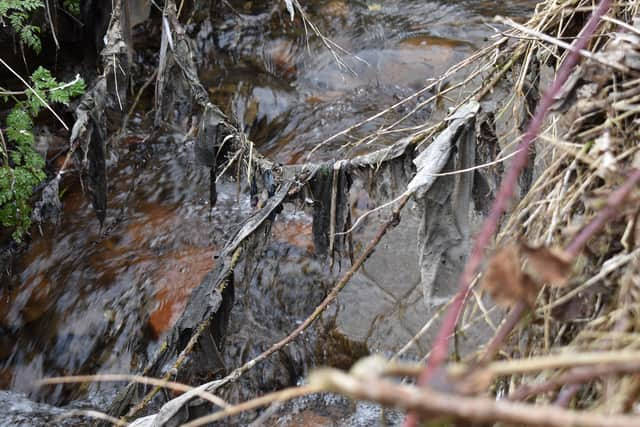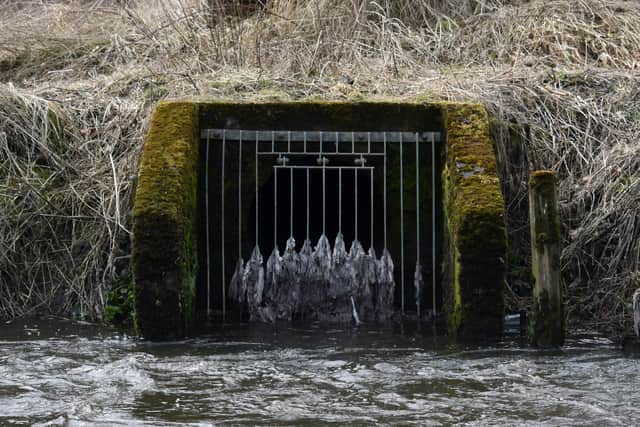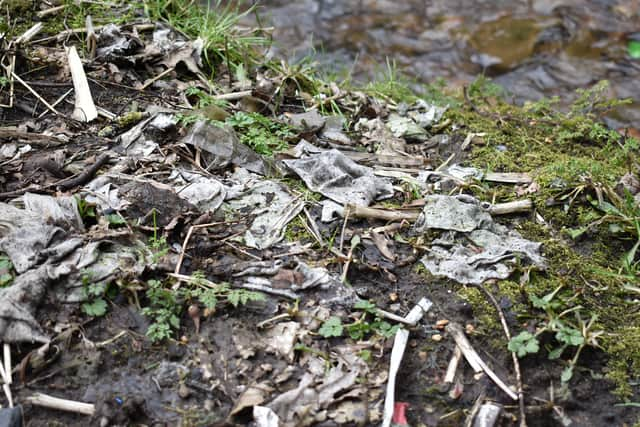Raw sewage in rivers: how bad is the problem in Manchester, and what needs to be done?
and live on Freeview channel 276
The issue of raw sewage ending up in our rivers and seas is currently top of the political agenda after a House of Commons vote rejecting an amendment on preventing discharges sparked waves of outrage.
But how bad is the problem in Manchester, what is causing it and what needs to be done?
Advertisement
Hide AdAdvertisement
Hide AdManchester World spoke to The Rivers Trust, which has been amassing data on environmental pollution, and water company United Utilities about sewage ending up in the city-region’s waterways.
What does the data for Manchester show?
The Rivers Trust, which is running a campaign to clean up rivers to the extent that they can be classed as bathing water across the UK, has produced a map of sewage discharges.
The map shows the scale of the problems in Manchester, with the dots and squares which indicate sewage discharges appearing regularly all along the blue lines of the city’s rivers and canals.
The majority of incidents in the city related to storm overflows of untreated sewage from infrastructure owned and maintained by the water company United Utilities.
Advertisement
Hide AdAdvertisement
Hide AdThere are also examples throughout the city of untreated sewage being discharged into the water from unknown and unmonitored sources.


In addition, there are a number of places where sewage in various stages of treatment is being discharged, with examples of this happening in Crumpsall and Ashton under Lyne.
In some places sewage discharge happens fairly frequently. In Julia Street, a storm overflow sewer discharged untreated sewage 125 times in 2020 for a total of 534 hours.
One in Corporation Street spilled 120 times for a total of 361 hours.
Advertisement
Hide AdAdvertisement
Hide AdAnd one on Potters Lane discharged sewage 280 times for a staggering total of 6,231 hours.
How bad is this problem?
Anneka France, a member of The Rivers Trust’s data and evidence team, said it is clear from the map that this is a serious issue for Manchester.
She said: “From looking at the map it doesn’t take a genius to see there’s a big problem in Manchester and a lot of sewage discharges have been happening, beyond what we would term acceptable.
“Water companies are supposed to keep the number of spills below a certain level and it is safe to say a lot of sites in and around Manchester are exceeding those levels.
“It doesn’t look great.
Advertisement
Hide AdAdvertisement
Hide Ad“Storm overflows are designed to overflow during exceptional weather events, such as storms. What you find from looking at this map is quite a few have been discharging over 100 times a year.
“We know we have not had 100 storms in a year. They shouldn’t be discharging that frequently.”
Why is this happening?
A number of reasons have been given to Manchester World to explain the sewage discharge data on the map.
Overflows and discharges can happen when the system becomes blocked, from things being put down toilet or into drains that shouldn’t be there.
Advertisement
Hide AdAdvertisement
Hide AdOne of the biggest issues, though, is that a lot of the infrastructure dates from the Victorian era and in addition to it being old has been installed in areas where the population has since grown considerably.
Climate change is also having an impact, with severe weather events becoming more frequent.


Another issue is the built environment itself, with large amounts of concrete and asphalt used in city centres. This prevents rainfall from being soaked up into the ground and causes it instead to run along the surface into drains.
Ms France said: “It is quite easy to point the finger at water companies. While they obviously have a huge part to play to treat sewage before it is released into the environment, there are a lot of wider issues.
Advertisement
Hide AdAdvertisement
Hide Ad“Sewers simply can’t cope with the capacity of waste now being produced, and more storms mean extra water going into the system.”
What is treated and untreated sewage and what impact does it have on the environment?
Treated sewage has gone through some of the treatment process before it is discharged, whereas untreated sewage is simply raw and happens when sewers overflow.
Ms France said: “Raw sewage discharges means they are releasing whatever someone has flushed down the toilet and it ends up in our rivers.
“You would be amazed at what people flush down the toilet. If you’re down by the river and you see sanitary towels or other things like that on the bank then it means untreated sewage has been released.”
Advertisement
Hide AdAdvertisement
Hide AdItems ending up in waterways without going through sewage treatment can have a serious impact on the health of both wildlife and humans using the rivers, canals or lakes.
Ms France said: “Raw sewage puts anyone wanting to use rivers for recreation at risk of becoming seriously ill.
“Plastics would normally be screened out and that can end up in the sea, contributing to a global problem, and a lot of our domestic chemicals can be seriously harmful to aquatic life.
“If you look at a bottle of washing-up liquid it will probably say it is harmful.”
Advertisement
Hide AdAdvertisement
Hide AdScience is still continuing to uncover the effects items we use from day to day, such as medicines or other drugs, can have if they end up in ecosystems.
Hormones from the contraceptive pill can affect the gender ratios in fish populations, and there is some research suggesting cocaine ending up in water can make fish behave in bolder ways.
What can be done?
Much of the attention is currently focused around water companies, with a huge political row having broken out following MPs’ decision not to support an amendment putting further pressure on them to do more to prevent discharges.
There was a massive social media backlash as residents and environmental organisations furiously demanded to know why politicians had effectively given a green light to dump sewage into rivers and seas, leading to a defensive response from the Conservative Party.


Advertisement
Hide AdAdvertisement
Hide AdWhile enforcement of regulations forms part of the solution, The Rivers Trust says it also wants to see the Government change the planning process so housebuilding companies have to do work on the sewage system to ensure it can accommodate large numbers of new homes.
It also wants to see more sustainable and green drainage solutions employed, particularly in urban areas, and reminded the public that it also has a role to play by not putting the wrong things down the toilet or into the drains.
What has United Utilities said?
United Utilities said it was committed to protecting water quality and river environments but also said it could not do this on its own and required financial assistance.
It also stressed that waterways have also improved considerably in the last couple of decades.
Advertisement
Hide AdAdvertisement
Hide AdA spokesperson said: “During storm conditions, when sewers and treatment plants are operating at full capacity, we are permitted to spill excess storm water from combined sewer overflows (CSOs) to help prevent the flooding of streets, homes and businesses.
“Over the past 20 years, United Utilities has invested £1.2bn improving CSOs to reduce the amount and impact of spills.
“We stand ready to invest further in our rivers to help bring about the transformation we all want to see.
“But for this investment, we’re calling on Government and Ofwat to match our ambition at the next price review.
Advertisement
Hide AdAdvertisement
Hide Ad“The water industry’s recent report sets out ten key steps necessary to achieve the radical changes we all want. We’re asking government to bring forward legislation in a new Rivers Act to provide greater protection for rivers.
“The Environment Agency estimates that CSOs lead to around 30 per cent of river and sea pollution in the North West, with the remaining 70 per cent due to other causes, such as rain running off highways and farm land, and private drainage being incorrectly connected.
“So, without everyone working together, we simply won’t get this radical change.”
What has The Rivers Trust said?
The Rivers Trust expressed its dismay that the amendment about preventing sewage discharges were removed by MPs from the Environment Bill, especially after it was recommended by the House of Lords.
Advertisement
Hide AdAdvertisement
Hide AdIt said the current Government plans do not compel water companies to take action immediately against pollution, meaning the quality of aquatic environments could continue to decline.
Including it in the bill would put it beyond legal doubt that all stakeholders have a responsibility to tackle the issue, The Rivers Trust said.
Mark Lloyd, the organisation’s CEO, said: “Despite a growing awareness of sewage pollution amongst politicians and the public, we have not seen decisive enough action which will actually change the course of river health.
“This amendment is what we need to accelerate investment and make a bold commitment to bring an end to sewage pollution so that the next generation can enjoy safe, healthy rivers with all the benefits they bring to us all.”
Comment Guidelines
National World encourages reader discussion on our stories. User feedback, insights and back-and-forth exchanges add a rich layer of context to reporting. Please review our Community Guidelines before commenting.